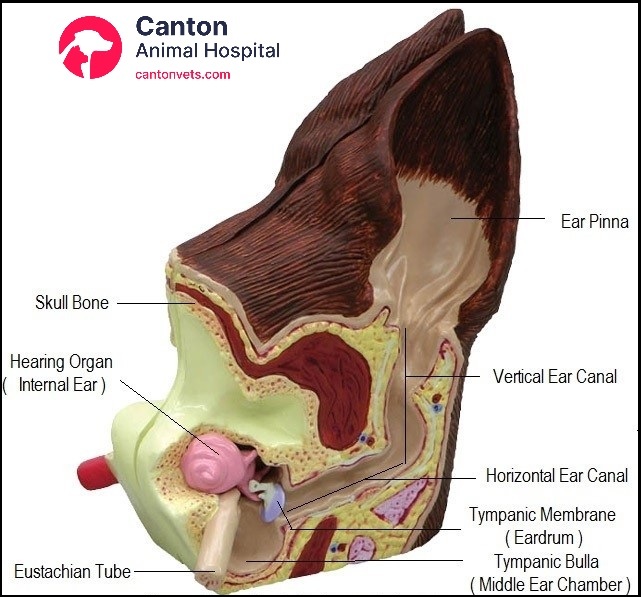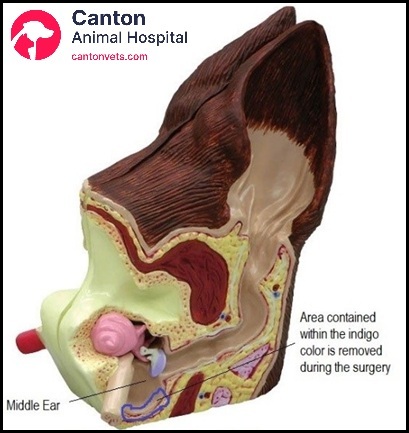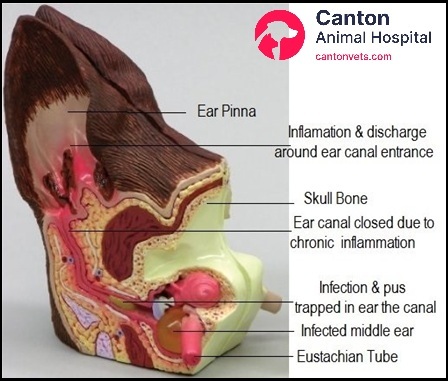Home | Medical Info | Ear Infections in Dogs & Cats
Ear Infections in Dogs & Cats
Keywords:
Comprehensive Care for Ear Infections in Dogs and Cats
At Canton Animal Hospital, we understand that ear infections are not only one of the most common reasons pets visit the vet—they're also one of the most frustrating conditions for pet owners to manage. Chronic ear infections can cause persistent discomfort, behavioral changes, and long-term damage if not properly addressed. They often stem from underlying health issues such as allergies, anatomical abnormalities, or parasites, making a one-size-fits-all approach ineffective.
Recognizing the signs early and pursuing appropriate veterinary care is critical. Pets suffering from ear infections may shake their head, scratch at their ears, or even show signs of pain when touched. In severe cases, infections can lead to hearing loss, balance issues, or facial nerve paralysis.
That’s why our experienced team provides comprehensive diagnostics and personalized treatment plans for every stage of ear disease.
Ear infections are categorized by the part of the ear affected. Understanding the differences can help pet owners recognize the severity and urgency of each condition.
Featured Resources

We Welcome New Patients!
We're always happy to give your furry friend care at our hospital. Get in touch today!
Contact Us
Otitis Externa
Inflammation or infection of the external ear canal, often caused by:
Allergies (food or environmental)
Moisture or water in the ears ("swimmer’s ear")
Bacterial or yeast overgrowth
Foreign bodies like grass seeds
Ear mites, especially in cats
Symptoms include head shaking, scratching, odor, redness, swelling, and ear discharge.

Otitis Media
An infection of the middle ear that can occur as a complication of untreated otitis externa or through perforation of the eardrum. It may cause:
Head tilt or balance issues
Facial nerve paralysis
Persistent ear discharge
Pain around the jaw or ear area
In cats, chronic or untreated infections can lead to the formation of inflammatory polyps in the middle ear. These polyps may obstruct the ear canal or grow into the nasopharynx, leading to respiratory issues or difficulty swallowing. In such cases, surgical removal is often necessary—most commonly through a Ventral Bulla Osteotomy (VBO) to fully access and excise the polyp and infected tissue. of untreated otitis externa or through perforation of the eardrum.
Otitis Interna
A more serious infection involving the inner ear. Often an extension of otitis media, it can lead to:
Severe balance problems (vestibular signs)
Nystagmus (involuntary eye movement)
Head tilt
Deafness
Loss of appetite or nausea from dizziness
Prompt treatment is critical to prevent permanent damage.
Ear Mite Infestation (Otodectes cynotis)
Ear mites are a common cause of ear infections, especially in kittens and puppies. Signs include:
• Intense itching and scratching • Coffee ground-like debris in ears • Inflammation and odor
They are highly contagious and require prompt diagnosis and treatment.

Diagnosing Ear Conditions
In many cases, chronic or recurring ear infections are symptoms of an underlying health issue rather than isolated conditions. Identifying and addressing these root causes—such as food or environmental allergies, endocrine disorders, or immune imbalances—is critical to achieving long-term resolution and preventing recurrence. Our diagnostic approach is thorough to ensure your pet receives the most effective and tailored care possible.
Accurate diagnosis is the foundation for successful treatment. At Canton Animal Hospital, we take a comprehensive approach to pinpoint the exact cause of your pet's ear issues.
A thorough ear exam includes:
Otoscope examination of the ear canal and tympanic membrane
Ear cytology to identify bacteria, yeast, or mites
Culture and sensitivity testing for resistant infections
Advanced imaging (CT or radiographs) for chronic or deep infections
Accurate diagnosis allows for effective, targeted treatment.
Treatment Options
Once a diagnosis is confirmed, our team develops a personalized treatment plan. Prompt intervention not only resolves current infections but also helps prevent long-term damage to your pet’s hearing and comfort.
Treatment depends on the underlying cause and severity:
Topical ear medications (antibiotic, antifungal, anti-inflammatory)
Oral medications in more advanced cases
Ear flushes and deep cleaning under sedation
Pain relief and anti-inflammatory drugs
Parasite treatments for ear mites
Surgical options for advanced otitis or anatomical issues (e.g., TECA-BO, VECA)
Preventing Recurrence
Ear infections often recur when underlying causes are not addressed. We work closely with pet owners to develop a maintenance plan that promotes long-term ear health and comfort.
Preventive care is essential to avoid chronic ear disease:
Regular ear cleaning and grooming
Managing allergies and underlying skin conditions
Monitoring for early signs of infection
Follow-up exams and rechecks
Common Types of Ear Infections
Below is a quick-reference table comparing common types of ear infections in dogs and cats:
Type of Infection | Location Affected | Common Causes | Key Symptoms |
Otitis Externa | External ear canal | Allergies, moisture, bacteria, mites | Redness, odor, discharge, scratching |
Otitis Media | Middle ear | Spread from externa, eardrum rupture | Head tilt, pain near ear, facial paralysis |
Otitis Interna | Inner ear | Advanced infection from media | Balance loss, head tilt, deafness, eye movement |
Ear Mites | External ear canal | Parasitic infestation (Otodectes) | Intense itch, dark debris, inflammation |
Understanding the differences can help pet owners recognize the severity and urgency of each condition.
Schedule an Ear Health Consultation
Your pet’s ears play a vital role in their well-being—from balance and hearing to comfort and behavior. Don't ignore the signs of ear disease—early treatment makes all the difference.
If your dog or cat is showing signs of an ear infection, don’t wait. Canton Animal Hospital provides effective diagnosis and treatment for all types of ear disease in pets.
📞 Call us today or Book an Appointment Online for compassionate, comprehensive ear care.
Featured Resources

We Welcome New Patients!
We're always happy to give your furry friend care at our hospital. Get in touch today!
Contact UsFrequently Asked Questions (FAQs)
If you're a pet parent dealing with ear infections, you likely have concerns about symptoms, treatment duration, and how to prevent recurrence. Here are some of the most common questions we hear:
